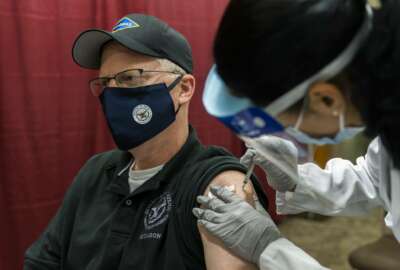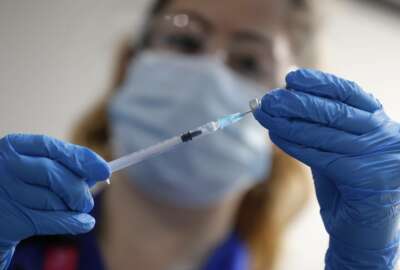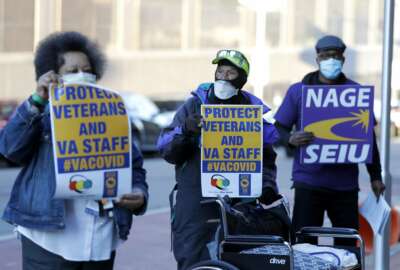
VA health care workers feeling pandemic burnout: ‘We don’t see the light at the end of the tunnel’
VA has paused its near-real-time public reporting of new COVID-19 cases, but as of Dec. 11, the department was tracking 17,757 active cases, including 1,441 VA...
With COVID-19 cases surging across the country, health care workers at the Department of Veterans Affairs say they’re feeling burned out, overwhelmed and unheard as the pandemic stretches on into 2021.
“A lot of my nurses are fatigued beyond belief,” said Geddes Scott, president of the AFGE local representing employees at the St. Albans Community Living Center in Queens, New York. “We’re talking about overtime and such, but just being in a situation where you’re dealing with COVID day in and day out from March until now, it has strained and stressed all of the nurses that we have on hand.”
VA has paused its near-real-time public reporting of new COVID-19 cases, but as of Dec. 11, the department was tracking 17,757 active cases. That total included 1,441 VA health care workers with active cases of COVID-19, according to VA’s public data.
As of Wednesday, 87 VA health care workers have died from complications due to COVID-19.
“We don’t see the light at the end of the tunnel,” Marcellus Shields, president of the AFGE local representing VA employees in Wilmington, Delaware, told reporters Wednesday.
He said he’s seeing more of his colleagues take family and medical leave now than ever before. Other AFGE leaders said they’re seeing more colleagues leave the agency out of exhaustion and frustration.
“It’s battle fatigue,” Shields said of the VA nurses. “They’re just done.”
AFGE local leaders say their VA medical facilities have been short-staffed for years, challenges that only compounded over the last nine months during the pandemic as frontline health care professionals test positive for COVID-19, care for family members or quarantine out of precaution.
Christina Noel, a VA spokeswoman, said the union’s comments “lack creditability,” though the department declined to speak directly to the union’s concerns about staffing shortages and low morale. Noel instead pointed to a VA report that shows the department hired nearly 66,000 employees between March 29 and Nov. 17.
Federal News Network has since asked VA for additional data on the number of employees who have left the agency since March and how many are on leave.
Throughout the pandemic, the department has maintained its employee infection rate is lower than most other major health care systems at less than 1%, data that VA reiterated this week.
Jessica Bonjorni, acting assistant deputy undersecretary for workforce services, said the Veterans Health Administration surveyed employees to learn how they were feeling during the pandemic.
“We found a really high level of dedication among our workforce,” she said earlier this month at ACT-IAC’s virtual health innovation conference. “They wanted to continue to work and serve our veterans. We had people who had delayed their retirements to make sure they could stay on and continue to provide care. But certainly people are anxious about meeting their own personal needs because we’re balancing what’s going on at work with a lot of really rapid change in people’s home lives.”
She said VA has expanded its in-house child care programs and stood up new ones with contractors to help alleviate some stress for employees with young children.
Still, AFGE local leaders said they’re seeing their colleagues become overwhelmed by the pandemic and are starting to burn out.
“They talk about combat fatigue for soldiers. What these nurses are going through is something very similar to that,” Scott said. “Where yeah, you can go home. I don’t get eight hours of sleep. I don’t get five hours of sleep. I barely get two, because your mind is consistently on what you have to go back in the building to deal with.”
The union and agency have been locked in contentious collective bargaining disputes for much of the last year. AFGE has said VA has refused to sit down at the bargaining table with the union during the pandemic.
“The worst part is that the agency won’t even listen to our input,” said Barbara Galle, president of the AFGE local representing employees at the Minneapolis VA Medical Center. “We represent the frontline staff, the people who are on the ground doing the job, who have been doing the job and know what they’re doing, and yet they won’t listen to these voices.”
Union leaders said each facility has its own challenges. Shields said his facilities in Delaware have “stepped up” their efforts to provide N95 masks and other personal protective equipment to frontline health care workers.
“I do want to commend Wilmington for doing its best to answer some of the issues that were presented to them, but there’s still a long way to go,” he said.
But in Minneapolis, Galle said the facility was withholding N95 masks from nurses.
“VA has put in place rigorous safety measures at all of its facilities, including employee and veteran COVID-19 screening, physical distancing and appropriate personal protective equipment such as face coverings,” Noel said Wednesday in an email to Federal News Network.
“Additionally, all VA medical centers have adequate capacity, PPE and supplies to meet current demand,” she added.
AFGE local leaders in Baltimore and Milwaukee said employees who are tested for COVID-19 often work a full shift or two before receiving test results.
Noel said the department is following guidance from the Centers for Disease Control and Prevention. The department has tested 1.1 million veterans and employees for COVID-19, she added.
“Per CDC guidance and VA protocols, employees exhibiting COVID-19 symptoms are immediately isolated to prevent potential spread to others,” Noel said.
As VA begins a sweeping effort to vaccinate nearly 248,000 health care workers and tens of thousands of other essential workers, AFGE said it’s looking for more details about the distribution process itself.
VA released its final vaccine distribution plan Tuesday. It received initial shipments of the Pfizer vaccine earlier this week and started to administer it to certain health care professionals at the highest risk for COVID-19.
But union local leaders said they’re looking for more specifics and reassurances that if employees have a reaction to the vaccine, other staff will be available to take their place.
“What happens if I have a reaction? Who’s going to track me?” Scott, the local president in New York, said. “There’s certain information that should be shared openly so there’s transparency. We already understand that people have issues with vaccines, but if you just don’t give the right information you’re setting it up for it not to work.”
VA has agreed to give employees who might have a reaction to the vaccine up to two days of administrative leave, said Milly Rodriguez, an AFGE health and safety specialist.
“Supervisors are being advised on how to track that,” she said. “But in terms of the real tracking of who is getting sick, who’s having reactions and when people are off, we don’t have a real good sense of how the VA is planning to handle that. If they do have that information, we don’t have it at this point.”
Copyright © 2025 Federal News Network. All rights reserved. This website is not intended for users located within the European Economic Area.
Nicole Ogrysko is a reporter for Federal News Network focusing on the federal workforce and federal pay and benefits.
Follow @nogryskoWFED
Related Stories

VA warns of ‘long process’ to distribute COVID-19 vaccine to employees and veterans





